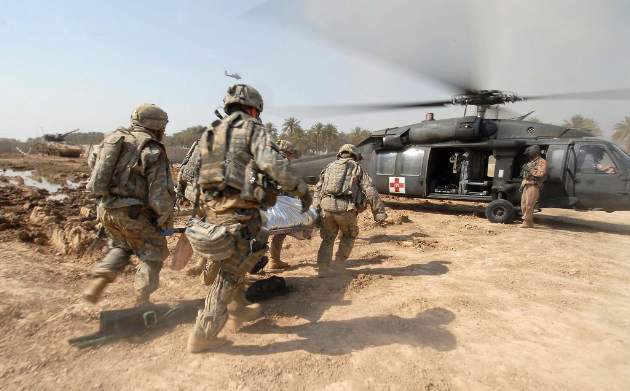Integrating military and civilian trauma care systems to create a single national system could reduce trauma deaths by 20% and save billions in medical costs and lost productivity, according to a study and report from the National Academies of Sciences, Engineering, and Medicine.
The committee of experts who conducted the study has called upon the White House to set an ambitious goal of establishing such a system and achieving zero preventable deaths after injury. The report , “A National Trauma Care System: Integrating Military and Civilian Trauma Systems to Achieve Zero Preventable Deaths After Injury,” outlines the steps needed to achieve the goal.
M. Margaret Knudson, MD, FACS, a trauma surgeon and professor of surgery at San Francisco General Hospital and Trauma Center, and medical director for the Military Health System Strategic American College of Surgeons (ACS) Partnership, praised the committee’s efforts, calling the 11 detailed recommendations in the report a potential “win-win.”
“It’s a brilliant report,” said Dr. Knudson, who was interviewed for the report but did not serve as a member because of her conflicting role as an employee of ACS, one of the organizations that commissioned the study.
The American College of Surgeons has taken a leadership role in promoting national improvements in readiness and training for mass trauma in U.S. hospitals. Following the 2012 mass shooting at Sandy Hook Elementary School in Newtown, Conn., the ACS developed the Hartford Consensus as a protocol for improving survivability from active shooter and mass shooting scenarios. Under the leadership of Lenworth Jacobs, MD, FACS, of Hartford Hospital, the Hartford Consensus has promoted the adoption of certain tactics used by the military in combat situations, including training of civilians and bystanders to control bleeding. The campaign to promote awareness of lifesaving hemorrhage control is ongoing and is currently supported by 40 partner organizations in the United States.
Despite the efforts of the ACS and other medical organizations, there are areas of the country that are not well served by a trauma system. Further, variations in practice exist throughout the country.
“So it’s a win-win situation for both the military and civilians if this can actually come about,” she said in an interview.
A national system would facilitate the information exchange and shared training between the military and civilian sectors; lessons learned on the battlefield could be applied in the civilian setting, and training of military personnel in the civilian setting during inter-war periods would help maintain battlefield readiness.
Increasing threats to homeland security, and devastating mass casualty incidents like the June 12, 2016, nightclub massacre in Orlando – the deadliest mass shooting by a single gunman in U.S. history – underscore the urgent need for such a system.
Trauma is the leading cause of death for Americans under age 46 years, the committee reported.
System integration
Integrating military and civilian trauma systems is not a new concept, according to committee member C. William Schwab, MD, FACS, of the University of Pennsylvania, Philadelphia.
“It’s the way the United States functioned for the first 175 years until Vietnam,” he said in an interview.
“What we’re doing is re-engineering and re-recommending that we go back, especially for severe injury trauma, to having constant dialogue and sharing between the military and civilian sectors,” he said.
As a former member of the military who completed his residency in the U.S. Navy, and a trauma surgeon who teaches military personnel at the University of Pennsylvania, Dr. Schwab has a unique perspective “of being not just a surgeon, but a trainer, and figuring out how to better prepare these young men and women to go off to war.”
One of the committee’s recommendations for achieving the stated goals deals specifically with this type of training.
“It’s actually about a ‘learning health system’ … we really felt that in order to achieve the aim of our report … we needed to combine the two systems so that there was bidirectional flow of information … and translation of experience into research,” Dr Schwab said.
The report was aimed at the White House, because of the number of departments – “from Health and Human Services, to Homeland Security, to Transportation, and even Justice” – whose efforts will be needed to ensure success.
“It will take a sustained effort in leadership to understand the problem and be able to help us lead the country to zero preventable deaths,” he said.
Military personnel very quickly develop the skills needed to care for the wounded during times of war, but those lessons and skills tend to be lost in the postwar period. With continuity of training and information exchange that can be afforded by an integrated system, there will be less of a need to recreate the wheel, he said. The benefits work both ways.
Historically, some important lessons learned on the battlefield have been adopted in the civilian setting, and it is imperative that the momentum that military personnel gain is not lost, as that momentum has led to more advanced care of the injured, and more advanced systems of care, reconstruction, and rehabilitation in the civilian setting, he explained.
One example is a change in blood product ratios used during damage-control resuscitation. The change – to a ratio that more closely resembles whole blood circulating in the body – was driven by lessons learned during the Iraq War.
“That approach was very rapidly diffused into the civilian sector, and we were really able to improve mortality by changing our practice based on what the military did,” said trauma surgeon and committee member Adil H. Haider, MD, FACS, of Brigham and Women’s Hospital and Harvard School of Public Health, Boston, who noted that fellow committee member and military trauma surgeon Dr. John Bradley Holcomb, MD, FACS, of the University of Texas Health Science Center in Houston, was instrumental in developing that new approach.
It’s all about the data
Dr. Haider’s area of interest is in analyzing large data systems. He recently published a study involving a survey of trauma center directors regarding progress in adopting military innovations into civilian trauma care. Some innovations, like the blood product ratio change, had “diffused really well” into civilian care, but others, like the use of tourniquets during prehospital care, had not. The process of military-to-civilian translation is important as optimization of care could substantially reduce the health care burden.
About 30,000 of the nearly 148,000 U.S. trauma deaths in 2014 may have been preventable with optimal trauma care, according to the committee’s findings. Further, trauma affects people in all walks of life. This isn’t just about shooting victims; it’s about older patients who trip on a loose carpet and experience a head injury, or an individual just going about his or her business and getting hit by a car, Dr. Haider said.
If improvements in trauma care could prevent 20% of deaths as the committee concluded, “just imagine how many disabilities and how much hardship could be prevented by investment in trauma care,” he said.
In 2013, trauma cost about $670 billion in care expenses and lost productivity, according to the report.
Improved collection and use of data isn’t a particularly exciting part of trauma care, but it is a particularly important part of improving it, and it is a key component of the committee’s recommendations, Dr. Haider added, explaining that “connecting prehospital data with hospital data and with long-term follow-up is … one of the most important things we need to do to improve the system. That’s the whole point – improving the system,” he said.
A related component of the report is the need for disaster readiness in the civilian sector, Dr. Knudson said.
“Particularly with what’s happened in Orlando and elsewhere, the need for civilians to be ready for disaster response and mass casualties is just as important as the need for the military to be ready,” she said.
As lofty as the goals and recommendations from the committee are, there is optimism that an integrated system is possible, and in fact, some of the recommendations contained in the report are already being worked on through the Military Health System–ACS partnership, including integration of data collected in military trauma registries and data collected on the civilian side. Also, subject matter experts have been brought together to develop uniform educational processes.
Dr. Haider added that “some of these recommendations are so straightforward and simple, if we’re able to get them enacted we could really change trauma care. This is not something that’s abstract; this will help you and me and our children any day of the week.”
The National Academies study was sponsored by the American College of Emergency Physicians, American College of Surgeons, National Association of EMS Physicians, National Association of Emergency Medical Technicians, Trauma Center Association of America, U.S. Department of Defense U.S. Department of Homeland Security, and U.S. Department of Transportation. Dr. Knudson is a paid employee of the ACS. Dr. Haider and Dr. Schwab reported having no disclosures.





